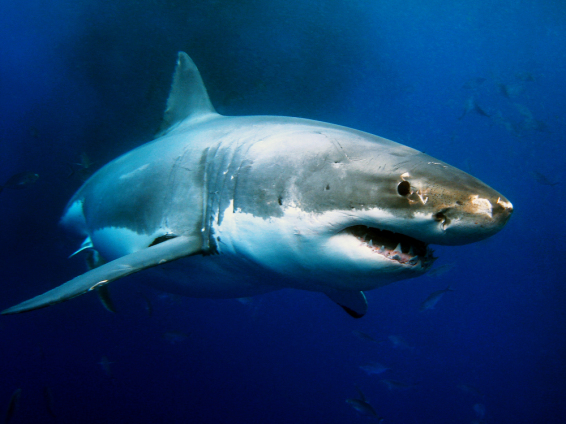
The Great White Shark(Carcharodon carcharias) also known as the White Shark, Great White, or White Pointer is a large cartilaginous fish that is classified in the Animalian class Chondrichthyes, order Lamniformes, and family Lamnidae.
| Genus | Carcharodon |
| Species | C. carcharias |
| Binomial Name | Carcharodon carcharias |
| Length | 3.1-6.4m(11-21 feet) |
| Weight | 522–3,401 kg(1,150.8-7,497.9 lbs.) |
| Diet | Carnivore |
| IUCN Status | Vulnerable |
Range and Habitat
Great White Sharks can be found in oceans across the world with the exception of arctic regions.
Physical Characteristics
Great White Sharks have a white underside and a gray dorsal area. Sometimes the dorsal area maybe a brown or blue shade. Great White Sharks have rows of serrated, triangular-shaped teeth. Every time a Great White Shark loses teeth a new row slides into place. This species loses only 1000 teeth over its lifespan.
Reproduction
Great White Sharks give birth to live young. The offspring of the Great White Shark hatch and develop in the uterus until birth, which occurs after an 11 month gestation period. Litter sizes can reach 14 pups. The pups are precocial.
Diet
Great White Sharks eat fish; such as other sharks, and rays. They also eat cetaceans, seals, sea lions, sea turtles, The Sea Otter(Enhydra lutris), and seabirds.
Fun Facts
- Great White Sharks have about 300 teeth.
- A Great White Shark can live for up to 70 years.
- A 20 foot(6.096 meters) long Great White Shark named Deep Blue was filmed off Mexico’s Guadalupe Island.
- Gansbaai is a town in South Africa and is the best location in the world for shark cage diving.
- The White Shark Trust tracked a young female Great White Shark from Gansbaai to Australia and back; The distance between both of these locations is 20, 000 km(12,427.4 miles), it took this shark less than 9 months to accomplish this feat.
